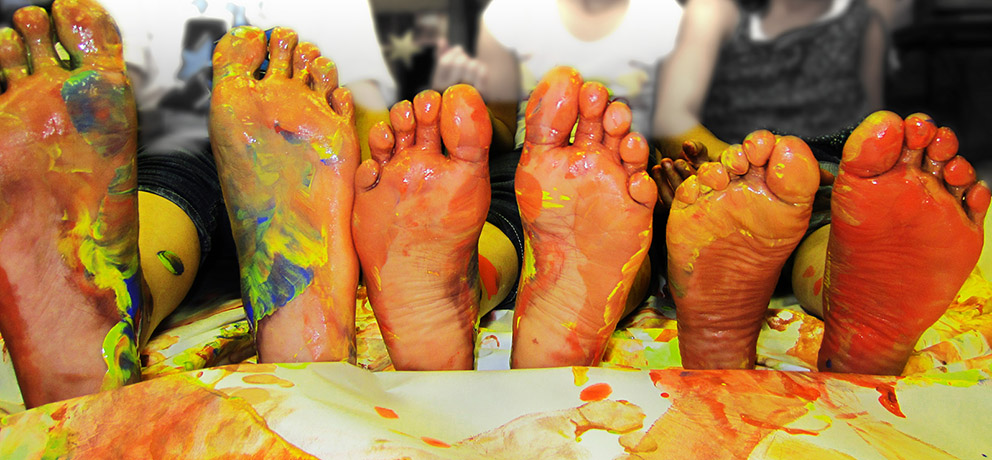
Things Every Parent should know about their children’s feet!
1.Growing feet are developing feet.
The foot is a complex structure comprised of 26 bones. These bones are designed to support the entire body, adapt to uneven surfaces and absorb shock. A baby’s foot contains more cartilage than bone, which, over time, will fuse and harden into adult bones. Although the structure of the foot develops fully by the first 2 years, the bones themselves will not fully develop and harden until around the age of 18. This is why it is crucial to have good shoes early on, so that the bones are allowed to develop naturally.
2. The younger the foot, the faster it grows.
The greatest changes in foot growth occur in the first 3 years. On average, a child will grow up to 12 sizes in just their first three years! This is why doctors recommend getting your toddler’s foot measured at least once every three months to ensure that their shoes fit properly. Shoes that are too small can deform the toes and permanently damage the foot. . This may mean getting your child a new pair of shoes every 3 to 6 months, but after the age 4, you can count on them lasting in one size for about 8 to 12 months. (this does not include exceptions due to growth spurts).
3. Kids’ feet handle more stress than adults feet.
Kids’ feet endure about 3 times more stress than the average adult foot. This is because of the greater proportion of high impact activities of children as compared to adults. Because of this high stress that a child’s foot endures, children should wear shoes with good shock absorption, a well-made foot bed, and durable soles. Flexibility is also very important in children’s shoes, it helps them to strengthen the muscles on their own!
4. Feet are the foundation for your whole body.
Doctors argue that most foot problems and pains in adulthood stem from ill-fitting shoes or poor foot experiences during childhood. It is important to remember that the foot is NOT a separate entity, but an integral body part that supports the entire skeletal structure. Also, almost all of the bones in the foot are cartilage until about age 5. Ill-fitting shoes put one at risk for injury or deformity later in life. Many problems with posture, walking, and even back pain can be associated with ill-fitting or poorly made shoes.
5. Arch Support for children should be different than arch support for adults.
Typically a child’s arch does not fully develop until puberty - in the first two years the arch may not be visible. In the early years of childhood, there is often a “fat” pad in the arch area of the foot, which gives the appearance of a flat foot, but this is not the case. It is a natural arch support. Therefore, many shoe companies for babies and toddlers do not include additional arch support, as it is not necessary. You may see at various times that your child’s foot turn in or out or may pronate due to the fact that the foot arch has not yet fully developed. This is normal, but if they begin to complain about pain they should be taken to a foot doctor. After the age of 3, look for shoes that include some type of arch support or high-quality foot bed, a well defined heel-contour, padded collars and, of course, flexibility and durability.
6. Shoes affect sweaty feet, and sweaty feet affect shoes.
Children’s foot sweats about 2-3 times more than an adult’s foot! This is one reason why kids are known to wear down shoes faster than adults. Sweating in a shoe day after day (especially if they only have one pair of shoes) will wear on the soft leather lining on the inside of the shoe. After months, it will cause the actual structure of the shoe to break down, literally from the inside out. Sweat is not only a concern for the durability of a shoe, but also because sweaty feet are more susceptible to catching various feet fungus and infections. Therefore, it is important to have a breathable shoe that allows the moisture and heat from your child’s foot to escape, letting cooler air in. Clean cotton socks also help to keep feet dry and fungus free. If a shoe looks worn from the inside after only a couple months, try changing out your kid’s socks twice a day.
7. Shoe materials make a difference.
Materials like leather and canvas are great for children’s shoes because they are breathable, flexible and durable. They stretch and soften with wear, which is good for an active little foot. Some synthetic materials will breathe and flex like leather or fabric, but some will not, so be careful when picking a shoe that uses synthetic material. Avoid plastics, as they do not breathe or stretch, and they can easily cause blistering and sweaty feet.
8. Too small or too large; why sizing matters
Shoes that are too small hinder proper foot growth, decrease circulation, cause blisters, ingrown toenails, and just plain hurt! Shoes that are too big can cause uncomfortable chafing or blisters on your child’s heel as well as prevent them from being able to grip the ground properly when running or climbing. Shoes that are too large also cause tripping on the front of the toe, risking serious injury.
9. Soft sole vs. hard sole
There are two opposing opinions regarding soft sole and hard sole shoes. Soft sole enthusiasts argue that there is such thing as a shoe with too much structure. If a child wears a shoe with built in arch support, a heavy solid sole, and lots of structure, the need for the child’s own muscles to work to find balance and strength is diminished. Their feet rely on the strength of the shoe, which impedes the development of muscles in the foot and ankle. Soft sole supporters also argue that a child should be able to feel the ground under his or her feet, as this allows for better balance and grip.
Supporters of hard sole shoes say that shoes with structure help to prevent foot problems such as flat feet, pronated feet (the falling in of an ankle) and the turning in our out of feet. They also argue that a hard sole serves as more protection from harmful objects like glass or sharp rocks, especially if the child is outside or on the playground. Both sides of the debate have valid points, but choosing a side may not be necessary, as many shoe companies have designed shoes that are a happy medium.
